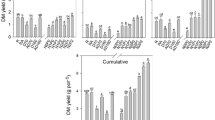Abstract
Ryegrass was grown, in pots under controlled-environment conditions, on soil mixed with each of ten slurries, eight from dairy farms and two from pig farms. In addition, ryegrass was grown under the same conditions but with the water-insoluble material separated from each slurry. Incorporation of the whole slurries increased the yield of herbage, the concentration of N in the herbage and N uptake, compared with plants grown on soil alone, the effects being greatest at the first of six successive harvests. In contrast, incorporation of the water-insoluble material of the cattle slurries decreased herbage yield and N uptake, particularly at the first harvest, but the water-insoluble material of the pig slurries produced some increase in herbage yield and N uptake.
The results indicate that the water-insoluble material of the cattle slurries immobilized N that would otherwise have been available from the water-soluble fraction of the whole slurries and/or from the soil. The recovery by the ryegrass of the water-soluble N from the whole slurries was closely correlated with the concentration of N in the water-insoluble material (r=0.863***) and negatively correlated with the C∶N ratio (r=0.892***). Correlations between the recovery of the water-soluble N and the concentrations of N in five particle size fractions of the water-insoluble material indicated that the fraction of smallest particle size (<0.2 mm) had the greatest effect.
Similar content being viewed by others
References
Amberger A, Vilsmeier K and Gutser R 1982 Stickstofffreaktionen verschiedener Güllen und deren Wirkung im Pflanzenversuch. Z. Pflanzenernaerhr Bodenk. 145, 325–336.
Chang A C and Rible J M 1975 Particle-size distribution of livestock wastes.In Proceedings of the 3rd International Symposium on Livestock Wastes. pp 339–343. American Society of Agricultural Engineers, St. Joseph, Michigan, USA.
Gehrke C W, Kaiser F E and Ussary J P 1968 Automated spectrophotometric method for nitrogen in fertilizers. Journal of the Association of Official Agricultural Chemists 51, 200–211.
Ministry of Agriculture, Fisheries and Food 1986 Profitable Use of Farm Manures. ADAS Booklet 2081. HMSO, London.
Pain B F, Smith K A and Dyer C J 1986 Factors affecting the response of cut grass to the nitrogen content of dairy cow slurry. Agric. Wastes 17, 189–202.
Ryden J C 1984 The flow of nitrogen in grassland. Proc. Fert. Soc, London. no. 229.
Unwin R J and Smith K A 1983 Fertilizer value of organic manures in the UK. Proc. Fert. Soc, London. no. 221.
Van Faassen H G and van Dijk H 1987 Manure as a source of nitrogen and phosphorus in soils.In Animal Manure on Grassland and Fodder Crops, Fertilizer or Waste. Ed. H G van der Meer, R J Unwin, T A van Dijk and G C Ennik. pp 27–45. Martinus Nijhoff, Dordrecht, The Netherlands.
Westerman P W, Safley L M, Barker J C and Chescheir G M 1985 Available nutrients in livestock waste.In Proceedings of the 5th International Symposium on Agricultural Wastes. pp 295–307. American Society of Agricultural Engineers, St. Joseph, Michigan, USA.
Author information
Authors and Affiliations
Rights and permissions
About this article
Cite this article
Whitehead, D.C., Bristow, A.W. & Pain, B.F. The influence of some cattle and pig slurries on the uptake of nitrogen by ryegrass in relation to fractionation of the slurry N. Plant Soil 117, 111–120 (1989). https://doi.org/10.1007/BF02206263
Received:
Revised:
Issue Date:
DOI: https://doi.org/10.1007/BF02206263




